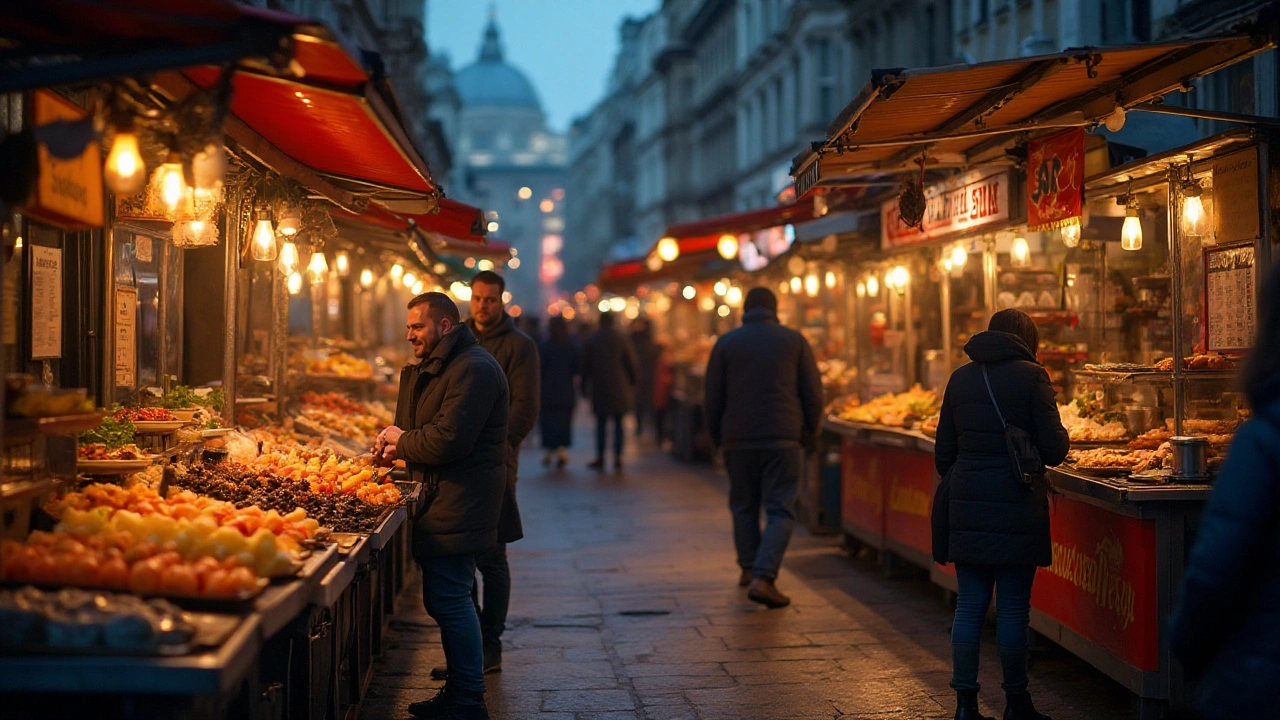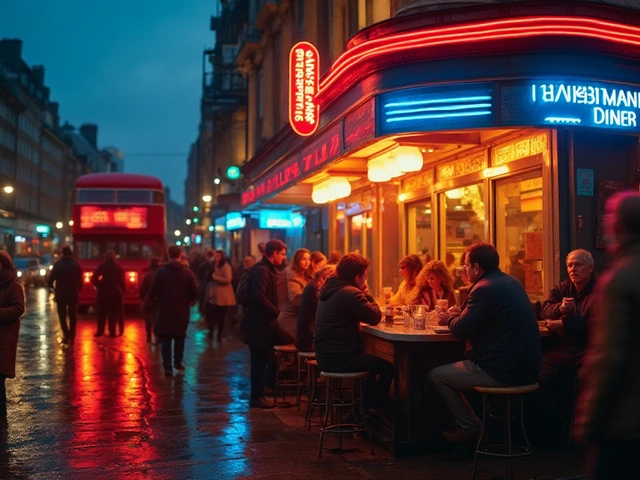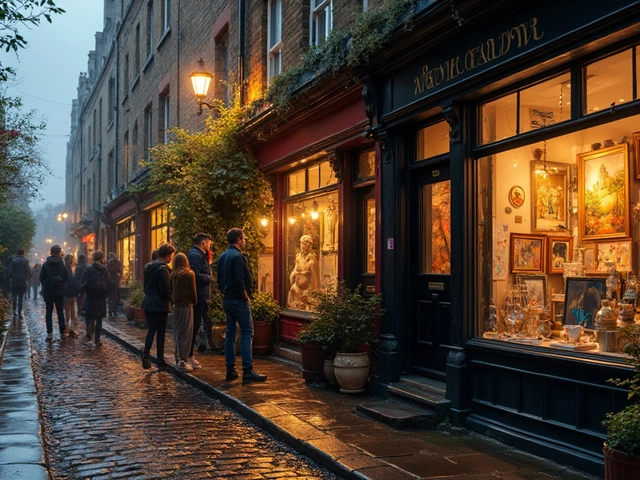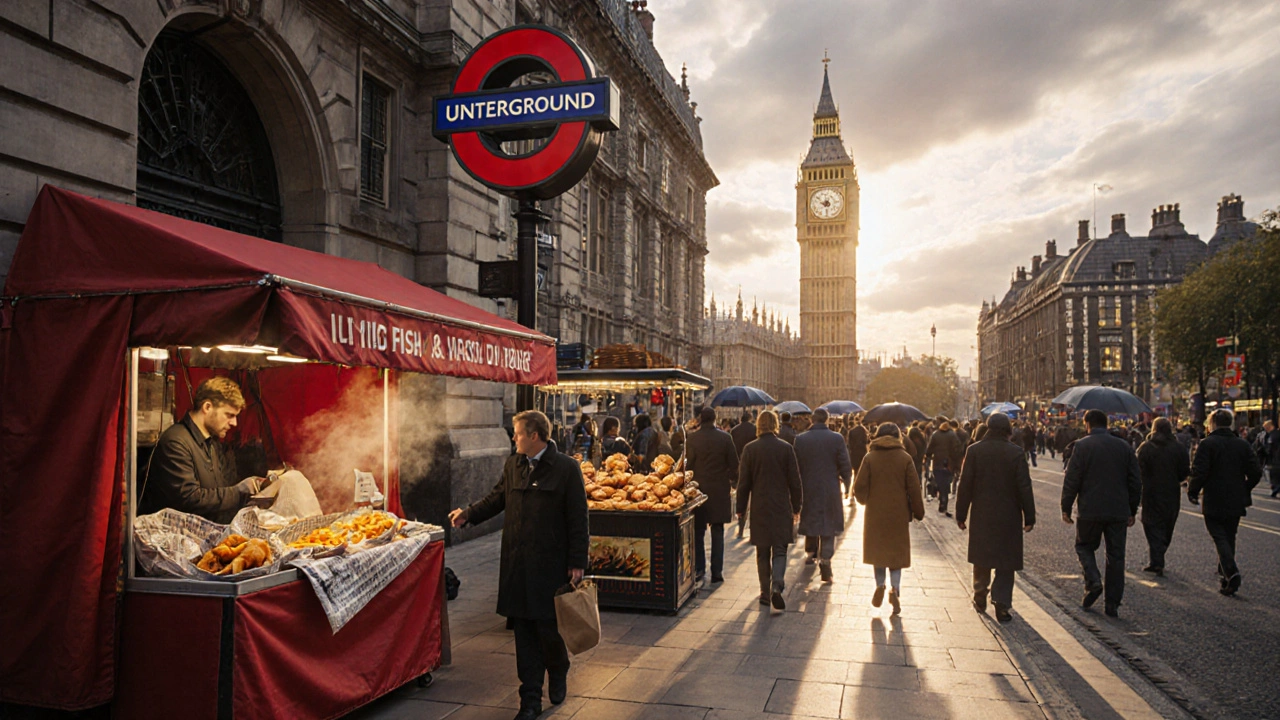
Key Takeaways
- London’s food scene blends historic comfort dishes with vibrant street‑food culture.
- Signature plates like Fish and Chips a battered cod served with chunky fries and mushy peas are still must‑tries.
- Traditional breakfasts, market stalls, and afternoon tea each showcase a different slice of the city’s culinary story.
- Best spots range from the historic pubs of Covent Garden to the bustling stalls of Borough Market.
- Knowing the typical price range and dietary tips helps you enjoy every bite without surprises.
Direct Answer
If you’re asking what food defines London, think of a hearty full English breakfast, crisp Fish and Chips, flaky pies with mash, a proper afternoon tea, and the sweet finish of sticky toffee pudding. These dishes are served in everything from century‑old pubs to modern market stalls, giving you a flavor tour of the capital.
Comprehensive Guide to London’s Famous Foods
Imagine stepping out of a tube station and being hit by the smell of fried batter, fresh pastry, and steeped tea. London’s food isn’t just about eating-it’s about experiencing a city that’s been a crossroads for centuries. From the working‑class roots of pie and mash to the royal rituals of afternoon tea, every bite tells a story. In this guide, we’ll wander through neighborhoods, uncover hidden stalls, and give you the practical tips you need to taste the capital like a local.
Definition and Context
London cuisine refers to the collection of dishes, markets, and eating traditions that have evolved within the Greater London area. It’s a melting pot of classic British comfort food, colonial influences, and modern street‑food innovation. While the city is famous for its diverse international eateries, the dishes that consistently surface in guides and conversations are those that have become cultural icons.
Benefits of Exploring London’s Iconic Dishes
Trying the city’s signature plates does more than satisfy hunger. You get a glimpse into London’s social history-why miners ate pies, why sailors loved fried fish, and why the aristocracy turned tea into a ceremony. Each dish also bridges generations; grandparents can still recall the same flavors they enjoyed in the 1950s, while today’s food‑truck vendors reinterpret them with new twists. Finally, tasting local favorites often leads you to the neighborhoods where the real community lives, from East End markets to South Kensington tea rooms.
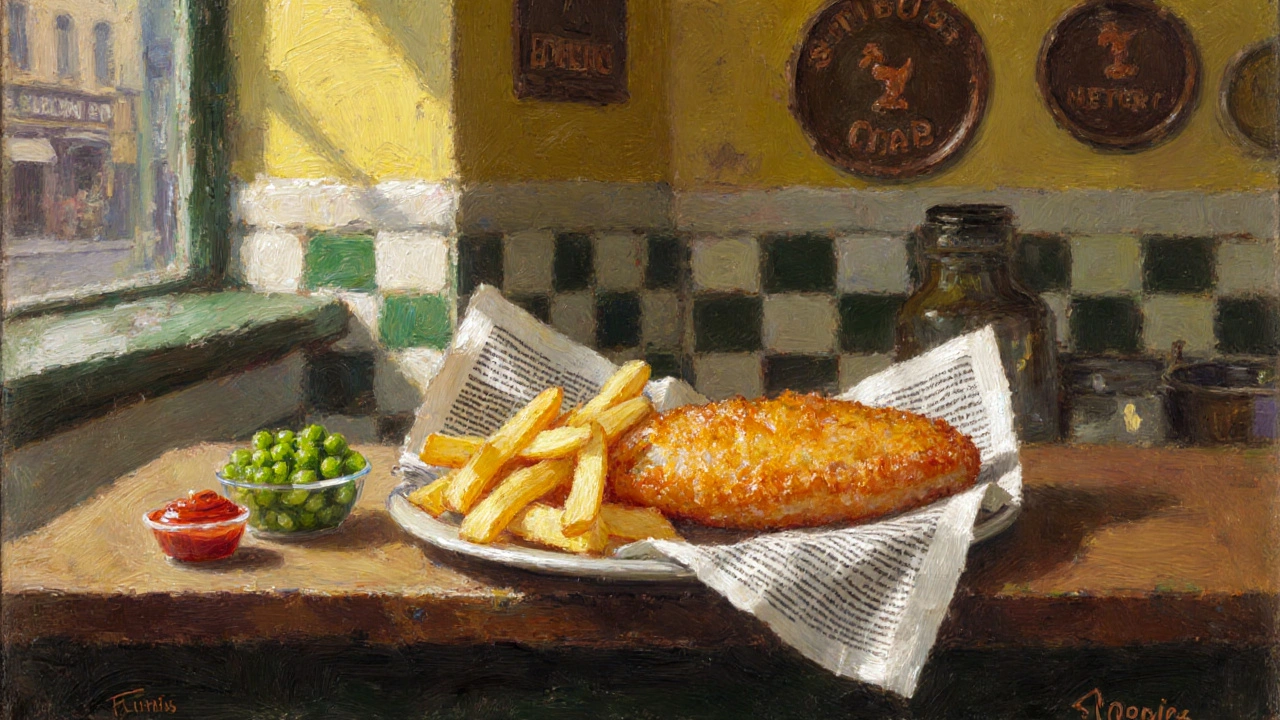
Types of Famous Foods Available in London
Below are the dishes you’ll hear locals rave about. We’ve marked each with microdata so search engines understand their importance.
- Fish and Chips Battered cod or haddock served with thick‑cut chips, mushy peas, and tartar sauce. Best enjoyed at a seaside‑style shop like Poppies in Spitalfields.
- Full English Breakfast Sausage, bacon, eggs, black pudding, baked beans, grilled tomato and toast. Try it at The Wolseley for a polished version or at a local café for a no‑frills plate.
- Pie and Mash Savory meat pies served with creamy mashed potatoes and parsley liquor (a green sauce). Historic East End shops like Mother Mash keep the tradition alive.
- Roast Beef & Yorkshire Pudding Slow‑roasted beef paired with fluffy, pop‑out Yorkshire pudding and gravy. Sunday roasts at The Hawksmoor are legendary.
- Afternoon Tea Loose‑leaf tea served with finger sandwiches, scones, clotted cream, and pastries. The Ritz and Hotel Café Royal offer classic service.
- Bangers and Mash Savory pork sausages over buttery mashed potatoes, topped with onion gravy. The Churchill Arms in Kensington serves a pub‑style version.
- Jellied Eels Eel meat set in a gelatinous broth, a true East End delicacy. Try the historic specialist at House of Reeves.
- Sticky Toffee Pudding Moist date cake drenched in buttery toffee sauce, often served with vanilla ice‑cream. The original recipe lives at the Old Coffee House.
Where to Find These Dishes in London
London’s neighborhoods each have a signature food hub. Here’s a quick map of where to go:
- Borough Market - Ideal for fresh seafood, artisan breads, and gourmet versions of fish & chips.
- Spitalfields - Home to the iconic Poppies and several modern brunch spots serving full English breakfasts.
- East End - The birthplace of pie and mash, jellied eels, and traditional pubs.
- South Kensington - Hosts elegant tea rooms like The Orangery for a proper afternoon tea.
- Covent Garden - Offers a mix of street food stalls and historic pubs serving Sunday roasts.
Tip: Use Google Maps and type the dish name plus “London” to locate the nearest specialist. Most places accept contactless payment and have online reservation options.
What to Expect During a Meal
When you sit down for a traditional dish, expect a relaxed pace. A full English breakfast will be served on a sturdy plate, with the components arranged so you can dig in at your own speed. Fish & chips often arrives in newspaper‑style wrapping-remember to ask for a napkin if it’s too greasy! Afternoon tea is a ceremony: the tea is poured from a teapot, and you’ll be offered a selection of pastries alongside the scones. Each experience is as much about the atmosphere as the food itself.
Pricing and Booking
Prices vary by location and ambiance. Rough ranges for 2025:
- Fish & chips from a stall: £7‑£12.
- Full English breakfast at a café: £10‑£15; at a hotel: £18‑£25.
- Afternoon tea at a luxury hotel: £45‑£65 per person.
- Sunday roast at a mid‑range pub: £15‑£20.
Most popular spots let you book a table online. For street food, simply walk in-early evenings are busiest.
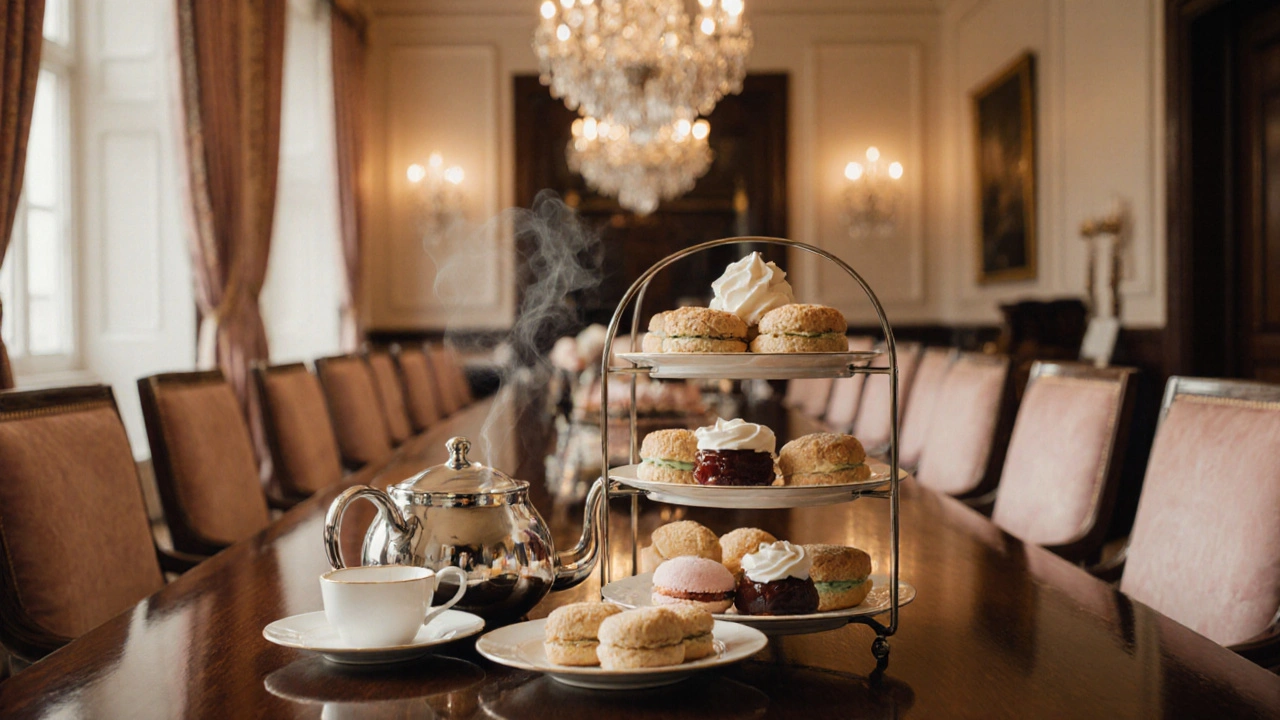
Safety Tips
- Check allergen information: many classic dishes contain dairy, gluten, or shellfish.
- If you’re trying raw or lightly cooked seafood, confirm the source’s hygiene rating (look for the “Food Hygiene Rating Scheme” stickers).
- Carry cash for smaller market stalls that may not accept cards.
- Mind the weather: outdoor markets can be chilly; bring a jacket.
Comparison Table: Iconic London Dish vs. Other UK Favorite
| Aspect | Fish and Chips (London) | Scottish Haggis |
|---|---|---|
| Main protein | Cod or haddock (battered) | Sheep’s heart, liver, lungs (minced) |
| Typical side | Thick‑cut chips, mushy peas | Neeps (turnips) and tatties (potatoes) |
| Best‑known venue | Poppies, Spitalfields | Traditional ‘haggis’ festivals in Edinburgh |
| Average price (2025) | £9‑£12 | £8‑£14 |
| Seasonality | Year‑round | Often featured in Burns Night (January) |
FAQ: Your Questions About London’s Famous Foods Answered
What’s the best time of day to try a full English breakfast?
Most locals head to a café between 7 am and 10 am. Restaurants may serve it all day, but the early hours give you the freshest ingredients and the classic vibe.
Are there vegan versions of traditional London dishes?
Yes-many pubs now offer plant‑based fishless ‘chips’ and vegan pies made with mushrooms or lentils. Afternoon tea can be adapted with dairy‑free scones and jam.
How do I know if a market stall’s fish is sustainably sourced?
Look for MSC (Marine Stewardship Council) labels or ask the vendor directly about the catch’s origin. Sustainable stalls often display the badge prominently.
Can I book a table for afternoon tea online?
All major hotels and many tea rooms provide online reservation forms. Booking 24‑48 hours ahead secures your slot, especially on weekends.
What’s the cheapest way to sample multiple iconic dishes?
Head to a market like Borough or Camden and try the “small plates” counters. You can grab a bite‑sized fish and chips, a mini pie, and a pastry for under £15.
Ready to Taste London?
If you’re hungry for a culinary adventure, start with a visit to a local market or book an afternoon tea at a historic venue. The city’s flavours are waiting-just follow your nose and enjoy the ride.
Comments (10)
- Abraham Pisico
- October 19, 2025 AT 17:33 PM
Ah, the noble pilgrimage through London’s culinary landscape-nothing says “I’ve emerged from a tube tunnel” quite like a battered cod clinging to a paper wrapper. I’m thrilled you’ve cataloged the staples, though I might add that the soul of the city lives in the hiss of the fryer as much as in the clink of fine china. Remember, a good fish and chips isn’t just food; it’s a philosophy about embracing greasy comfort while pretending to be sophisticated. So grab a seaside‑style coat, head to Poppies, and let the crispy chorus of batter sing you a lullaby of irony.
- Tarapada Jana
- October 19, 2025 AT 18:56 PM
The author’s enumeration of iconic dishes, while thorough, merely scratches the surface of London’s culinary hierarchy. One must distinguish between the pedestrian fare of market stalls and the artisanal renditions that truly merit scholarly attention. The guide neglects to acknowledge the nuanced terroir of sustainable sourcing, a glaring omission for any serious gastronome. In essence, the piece reads as a superficial checklist rather than an incisive critique of the capital’s edible heritage.
- Lippard Babette
- October 19, 2025 AT 20:20 PM
Love how the guide stitches together the history and the present-makes it feel like a walk with a friendly local showing you their favorite haunts. The tip about Googling dish names plus “London” is super handy and will save a lot of wandering around aimlessly. I also appreciate the note on bringing cash for market stalls; I’ve learned that the hard way more than once! Thanks for the balanced mix of tradition and modern twists, it really feels like an invitation to explore.
- Srimon Meka
- October 19, 2025 AT 21:43 PM
Alright, listen up-if you think a full English breakfast is just a lazy plate, you’re missing the whole point. It’s a ritual that demands discipline: the sausage must snap, the beans should simmer with purpose, and the coffee-if you dare-must be strong enough to awaken your inner warrior. Treat each bite like a training rep; push through the grease and emerge stronger, more alert, ready to conquer the city’s hustle. So next time you’re at The Wolseley, don’t just eat-attack the plate with intent.
- Cheryl Ying
- October 19, 2025 AT 23:06 PM
Ah, the grandiose proclamation of “must‑try” dishes-how wonderfully predictable! One can almost hear the echo of tourists huffing after a greasy fry, oblivious to the cultural weight they pretend to digest. While the guide’s earnestness is endearing, it drips with the same lazy reverence that most travel blogs flaunt. Still, perhaps somewhere between the sighs of steam and the clatter of cutlery, a genuine flavor lurks, waiting for a discerning palate.
- William Driscoll
- October 20, 2025 AT 00:30 AM
The exposition on London’s gastronomic staples, though comprehensive in scope, suffers from a series of structural and factual inconsistencies that merit meticulous scrutiny. Firstly, the assertion that “Fish and Chips is a year‑round staple” disregards seasonal variations in fish stock quality, which are documented by the Marine Stewardship Council’s annual reports. Secondly, the price ranges provided lack granularity; a £7–£12 bracket for a stall fails to account for the premium charged at heritage venues such as Poppies, where prices regularly exceed £12. Thirdly, the guide conflates “full English breakfast” with “polished version” without delineating the specific components that differentiate a culinary experience in a hotel setting from that of a local café. Moreover, the reference to “parsley liquor” accompanying pie and mash is inaccurate, as the traditional accompaniment is a green liquor composed of parsley, mint, and chives, distinct from any alcoholic concoction. The omission of dietary considerations beyond allergen warnings-such as the prevalence of high‑sodium content in traditional gravies-represents a notable oversight for health‑conscious travelers. In addition, the statement that “Afternoon tea at luxury hotels costs £45–£65” omits the fact that many establishments now offer tiered menus, with premium options surpassing £100 during peak seasons. The guide’s encouragement to “use Google Maps and type the dish name plus ‘London’” is technically sound but neglects to advise users of the importance of verifying the latest hygiene ratings, an essential step highlighted by the Food Standards Agency. Furthermore, the discussion of “Jellied Eels” fails to address the historic decline in eel populations and the resultant ethical concerns surrounding their consumption. The claim that “most popular spots let you book a table online” is broadly accurate, yet the guide does not distinguish between venues that require a deposit versus those offering free reservations. Finally, while the inclusion of a comparison table between Fish and Chips and Scottish Haggis is creative, it inadvertently perpetuates a simplistic binary that overlooks the rich diversity of regional British cuisine. In sum, the article presents a valuable overview yet requires substantial refinement to achieve encyclopedic rigor. Readers seeking a more nuanced pilgrimage should consult the official transport and culinary heritage sites for up‑to‑date information. Until then, this guide serves as a lively, if imperfect, compass for the hungry explorer.
- matthew mcclane
- October 20, 2025 AT 01:53 AM
Spot on-those cash‑only stalls can catch you off guard, so a spare note is always a smart travel hack.
- Emmanuel Jolly
- October 20, 2025 AT 03:16 AM
Indeed, the breakfast battlefield you described mirrors the larger struggle of modern London: ancient traditions pitted against the relentless march of convenience. While the fry‑sizzle symphony may seem a mere culinary ritual, it is, in fact, a microcosm of the city’s perpetual negotiation between heritage and hustle. To truly honor the plate, one must respect the provenance of every ingredient, lest we reduce centuries of labor to a hurried Instagram story. Yet, there remains a poetic justice in the grease‑glossed armor that fuels the urban explorer’s quest. Let this be a reminder that every bite is a dialogue with history, whispered through batter and bacon.
- Krishna Prasad Regmi
- October 20, 2025 AT 04:40 AM
Exactly-embrace that dialogue and let it energize your next adventure. Keep the curiosity alive, and you’ll turn every ordinary meal into a lesson in resilience.
- Patti Towhill
- October 20, 2025 AT 06:03 AM
Can’t wait to try the sticky toffee pudding at the Old Coffee House-heard it’s legendary!


